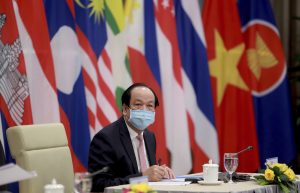If, as many analysts hold, 2020 marked the start of a turning point in global history, 2021 will be the first year were we being to see the consequences. For Southeast Asia, it will be an eventful year. The incoming Biden administration will look to shore up its influence on the region, and Southeast Asian states will be keen to see what to expect from a post-Trump United States. COVID-19, meanwhile, will continue to be the most pressing issue, with potentially lasting ramifications for China’s role in the region. And, of course, there are long-standing problems like the South China Sea disputes and broader U.S.-China competition to be wrestle with as well.
In this interview, The Diplomat’s Sebastian Strangio asks Richard Heydarian, a Manila-based academic and author of “The Rise of Duterte” and “The Indo-Pacific: Trump, China and the New Struggle for Global Mastery,” about the biggest issues facing Southeast Asia in 2021.
In terms of its personnel, the incoming Biden administration looks something like a third Obama term, which would seem to suggest a break from Trump’s approach to foreign policy in general, and the Indo-Pacific in particular. Do you think the incoming administration will represent continuity or change in its Southeast Asia policy? If the latter, where do you expect the change to come?
While it’s true that President-elect Joe Biden signaled his categorical repudiation of Trump-era unilateralism by declaring “America is back,” there is a reason why the former vice president also made it crystal clear that “this is not a third Obama term.” One needs not to be a refined dialectician to figure out that it’s impossible to return to a past that has changed beyond recognition. At best, Biden can and should improve on the brazen deficiencies of his predecessors’ China policy, not only Trump’s but also those of his Democratic predecessors since the end of Cold War. The most realistic option is a “Cold Peace” with China, whereby Biden simultaneously seeks détente and cooperation in areas of common understanding, but also vigorously pushes back against any Chinese strategic aggression.
In the case of Obama, he was simply too predictable and risk-averse to prevent China from radically reshaping the global order with Chinese characteristics. The most potent expression of Obama-era strategic infecundity is the unprecedented, years-long geoengineering and, soon after, all-out militarization of the South China Sea disputes. Way more than the “Syria red line” debacle, it was actually Obama’s practical abandonment of the Philippines, a treaty ally, during the 2012 Scarborough Shoal crisis that emboldened China’s worst instincts. And what was Obama’s response to China’s mega economic projects from the Asian Infrastructure Investment Bank to the Belt and Road Initiative? Snobbery and nonchalance, if not fecklessness? Biden clearly recognizes this, which perfectly explains his unmistakable abandonment of the whole “strategic empathy” gibberish in the early-2010s.






























